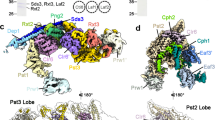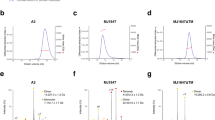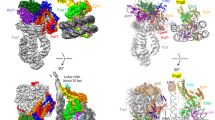Abstract
Site-specific lysine methylation of histones by SET domains is a hallmark for epigenetic control of gene transcription in eukaryotic organisms. Here we report that a SET domain protein from Paramecium bursaria chlorella virus can specifically di-methylate Lys27 in histone H3, a modification implicated in gene silencing. The solution structure of the viral SET domain reveals a butterfly-shaped head-to-head symmetric dimer different from other known protein methyltransferases. Each subunit consists of a Greek-key antiparallel β-barrel and a three-stranded open-faced sandwich that mediates the dimer interface. Cofactor S-adenosyl-L-methionine (SAM) binds at the opening of the β-barrel, and amino acids C-terminal to Lys27 in H3 and in the flexible C-terminal tail of the enzyme confer the specificity of this viral histone methyltransferase.
This is a preview of subscription content, access via your institution
Access options
Subscribe to this journal
Receive 12 print issues and online access
$189.00 per year
only $15.75 per issue
Buy this article
- Purchase on Springer Link
- Instant access to full article PDF
Prices may be subject to local taxes which are calculated during checkout






Similar content being viewed by others
References
Tschiersch, B. et al. The protein encoded by the Drosophila position-effect variegation suppressor gene Su(var)3-9 combines domains of antagonistic regulators of homeotic gene complexes. EMBO J. 13, 3822–3831 (1994).
Jones, R.S. & Gelbart, W.M. The Drosophila Polycomb-group gene Enhancer of Zeste contains a region with sequence similarity to Trithorax. Mol. Cell. Biol. 13, 6357–6366 (1993).
Stassen, M.J., Bailey, D., Nelson, S., Chinwalla, V. & Harte, P.J. The Drosophila Trithorax proteins contain a novel variant of the nuclear receptor type DNA binding domain and an ancient conserved motif found in other chromosomal proteins. Mech. Dev. 52, 209–223 (1995).
Schultz, J., Milpetz, F., Bork, P. & Ponting, C.P. SMART, a simple modular architecture research tool: identification of signaling domains. Proc. Natl. Acad. Sci. USA 95, 5857–5864 (1998).
Jenuwein, T. Re-SET-ting heterochromatin by histone methyltransferases. Trends Cell Biol. 11, 266–273 (2001).
Lachner, M. & Jenuwein, T. The many faces of histone lysine methylation. Curr. Opin. Cell Biol. 14, 286–298 (2002).
Kouzarides, T. Histone methylation in transcriptional control. Curr. Opin. Genet. Dev. 12, 198–209 (2002).
Jenuwein, T. & Allis, C.D. Translating the histone code. Science 293, 1074–1080 (2001).
Turner, B.M. Cellular memory and the histone code. Cell 111, 285–291 (2002).
Lachner, M., O'Carroll, D., Rea, S., Mechtler, K. & Jenuwein, T. Methylation of histone H3 lysine 9 creates a binding site for HP1 proteins. Nature 410, 116–120 (2001).
Bannister, A.J. et al. Selective recognition of methylated lysine 9 on histone H3 by the HP1 chromo domain. Nature 410, 120–124 (2001).
Nakayama, J., Rice, J.C., Strahl, B.D., Allis, C.D. & Grewal, S.I. Role of histone H3 lysine 9 methylation in epigenetic control of heterochromatin assembly. Science 292, 110–113 (2001).
Noma, K.-I., Allis, C.D. & Grewal, S.I. Transitions in distinct histone H3 methylation patterns at the heterochromatin domain boundaries. Science 293, 1150–1155 (2001).
Schotta, G. et al. Central role of Drosophila SU(VAR)3-9 in histone H3-K9 methylation and heterochromatic gene silencing. EMBO J. 21, 1121–1131 (2002).
Nielsen, S.J. et al. Rb targets histone H3 methylation and HP1 to promoters. Nature 412, 561–565 (2001).
Strahl, B.D. et al. Set2 is a nucleosomal histone H3-selective methyltransferase that mediates transcriptional repression. Mol. Cell Biol. 22, 1298–1306 (2002).
Litt, M.D., Simpson, M., Gaszner, M., Allis, C.D. & Felsenfeld, G. Correlation between histone lysine methylation and developmental changes at the chicken β-globin locus. Science 293, 2453–2455 (2001).
Heard, E. et al. Methylation of histone H3 at Lys-9 is an early mark on the X chromosome during X inactivation. Cell 107, 727–738 (2001).
Tamaru, H. & Selker, E.U. A histone H3 methyltransferase controls DNA methylation in Neurospora crassa. Nature 414, 277–283 (2001).
Taverna, S.D., Coyne, R.C. & Allis, C.D. Methylation of histone H3 at lysine 9 targets programmed DNA elimination in Tetrahymena. Cell 110, 701–711 (2002).
Rea, S. et al. Regulation of chromatin structure by site-specific histone H3 methyltransferases. Nature 406, 593–599 (2000).
Briggs, S.D. et al. Histone H3 lysine 4 methylation is mediated by Set1 and required for cell growth and rDNA silencing in Saccharomyces cerevisiae. Genes Dev. 15, 3286–3295 (2001).
Wang, H. et al. Purification and functional characterization of a histone H3-lysine 4-specific methyltransferase. Mol. Cell 8, 1207–1217 (2001).
Nishioka, K. et al. Set9, a novel histone H3 methyltransferase that facilitates transcription by precluding histone tail modifications required for heterochromatin formation. Genes Dev. 16, 479–489 (2001).
Tachibana, M., Sugimoto, K., Fukushima, T. & Shinkai, Y. Set domain-containing protein, G9a, is a novel lysine-preferring mammalian histone methyltransferase with hyperactivity and specific selectivity to lysines 9 and 27 of histone H3. J. Biol. Chem. 276, 25309–25317 (2001).
Fang, J. et al. Purification and functional characterization of SET8, a nucleosomal histone H4-lysine 20-specific methyltransferase. Curr. Biol. 12, 1086–1099 (2002).
Santos-Rosa, H. et al. Active genes are tri-methylated at K4 of histone H3. Nature 419, 407–411 (2002).
Czermin, B. et al. Drosophila Enhancer of Zeste/ESC complexes have a histone H3 methyltransferase activity that marks chromosomal Polycomb sites. Cell 111, 185–196 (2002).
Van Etten, J.L. & Meints, R.H. Giant viruses infecting algae. Annu. Rev. Microbiol. 53, 447–494 (1999).
Li, Y. et al. Analysis of 74 kb of DNA located at the right end of the 330-kb chlorella virus PBCV-1 genome. Virology 237, 360–377 (1997).
Cao, R. et al. Role of histone H3 lysine 27 methylation in Polycomb-group silencing. Science 298, 1039–1043 (2002).
Muller, J. et al. Histone methyltransferase activity of a Drosophila Polycomb group repressor complex. Cell 111, 197–208 (2002).
Strahl, B.D. & Allis, C.D. The language of covalent histone modifications. Nature 403, 41–45 (2000).
Sattler, M., Schleucher, J. & Griesinger, C. Heteronuclear multidimensional NMR experiments for the structure determination of proteins in solution employing pulsed field gradients. Prog. NMR Spectrosc. 34, 93–158 (1999).
Clore, G.M. & Gronenborn, A.M. Multidimensional heteronuclear nuclear magnetic resonance of proteins. Methods Enzymol. 239, 249–363 (1994).
Richardson, J.S. The anatomy and taxonomy of protein structure. Adv. Protein Chem. 34, 167–339 (1981).
Zhang, X., Zhou, L. & Cheng, X. Crystal structure of the conserved core of protein arginine methyltransferase PRMT3. EMBO J. 19, 3509–3519 (2000).
Weiss, V.H. et al. The structure and oligomerization of the yeast arginine methyltransferase, Hmt1. Nat. Struct. Biol. 7, 1165–1171 (2000).
Rozovskaia, T. et al. Trithorax and ASH1 interact directly and associate with the trithorax group-responsive bxd region of the Ultrabithorax promoter. Mol. Cell Biol. 19, 6441–6447 (1999).
Rozovskaia, T. et al. Self-association of the SET domains of human ALL-1 and of Drosophila TRITHORAX and ASH1 proteins. Oncogene 19, 351–357 (2000).
Wilson, J. et al. Crystal structure and functional analysis of the histone methyltransferase SET7/9. Cell 111, 105–115 (2002).
Jacobs, S.A. et al. The active site of the SET domain is constructed on a knot. Nat. Struct. Biol. 9, 833–838 (2002).
Zhang, X. et al. Structure of the Neurospora SET domain protein DIM-5, a histone H3 lysine methyltransferase. Cell 111, 117–127 (2002).
Min, J., Zhang, X., Cheng, X., Grewal, S.I. & Xu, R.M. Structure of the SET domain histone lysine methyltransferase Clr4. Nat. Struct. Biol. 9, 828–832 (2002).
Trievel, R., Beach, B., Dirk, L., Houtz, R. & Hurley, J. Structure and catalytic mechanism of a SET domain protein methyltransferase. Cell 111, 91–103 (2002).
Yamazaki, T., Lee, W., Arrowsmith, C.H., Mahandiram, D.R. & Kay, L.E. A suite of triple resonance NMR experiments for the backbone assignment of 15N, 13C, 2H labeled proteins with high sensitivity. J. Am. Chem. Soc. 116, 11655–11666 (1994).
Farrow, N.A. et al. Backbone dynamics of a free and phosphopeptide-complexed Src homology 2 domain studied by 15N NMR relaxation. Biochemistry 33, 5984–6003 (1994).
Delaglio, R. et al. NMRPipe: a multidimensional spectral processing system based on UNIX pipes. J. Biomol. NMR 6, 277–293 (1995).
Johnson, B.A. & Blevins, R.A. NMRView: a computer program for the visualization and analysis of NMR data. J. Biomol. NMR 4, 603–614 (1994).
Brunger, A.T. X-PLOR version 3.1: a system for X-ray crystallography and NMR (Yale University Press, New Haven; 1993).
Nilges, M. & O'Donoghue, S. Ambiguous NOEs and automated NOE assignment. Prog. NMR Spectrosc. 32, 107–139 (1998).
Nilges, M. A Calculation strategy for the structure determination of symmetry dimers by 1H NMR. Proteins 17, 297–309 (1993).
Acknowledgements
We thank J. Van Etten for providing the cDNA clone of PBCV-1 SET domain protein, and L. Chen and S. Mutjaba for technical advice. We are also grateful to A. Lustig (Biozentrum, University of Basel, Switzerland) for performing the analytic ultracentrifugation experiments. A.F. is a recipient of a Wellcome Trust Postdoctoral Fellowship. The work was supported by a grant from the National Institutes of Health to M.-M.Z.
Author information
Authors and Affiliations
Corresponding author
Ethics declarations
Competing interests
The authors declare no competing financial interests.
Rights and permissions
About this article
Cite this article
Manzur, K., Farooq, A., Zeng, L. et al. A dimeric viral SET domain methyltransferase specific to Lys27 of histone H3. Nat Struct Mol Biol 10, 187–196 (2003). https://doi.org/10.1038/nsb898
Received:
Accepted:
Published:
Issue Date:
DOI: https://doi.org/10.1038/nsb898
This article is cited by
-
Identification and characterization of SET domain family genes in bread wheat (Triticum aestivum L.)
Scientific Reports (2020)
-
Why are so many MLL lysine methyltransferases required for normal mammalian development?
Cellular and Molecular Life Sciences (2019)
-
A bacteria colony-based screen for optimal linker combinations in genetically encoded biosensors
BMC Biotechnology (2011)
-
Epigenetic transcriptional repression of cellular genes by a viral SET protein
Nature Cell Biology (2008)
-
Natural history of S-adenosylmethionine-binding proteins
BMC Structural Biology (2005)



